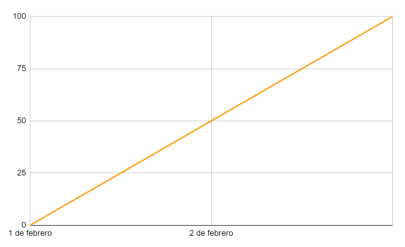![]()
Revista de Ciencias de la Comunicación e Información. 2024. Vol. 29, 1-24
ISSN 2695-5016
NEW SCIENTIFIC DISSEMINATION APPLICATIONS FOR UNIVERSITY STUDENTS: TINDER
NUEVAS APLICACIONES DE DIVULGACIÓN CIENTÍFICA PARA UNIVERSITARIOS: TINDER
Anna I. López Ortega[1]: International University of Valencia. Spain.
Javier Almela Baeza: University of Murcia. Spain.
Juan José Munafó Horta: International University of Valencia. Spain.
How to cite this article:
López Ortega, Anna Isabel; Almela Baeza, Javier, & Munafó Horta, Juan José (2024). New scientific dissemination applications for university students: Tinder [Nuevas aplicaciones de divulgación científica para universitarios: Tinder]. Revista de Ciencias de la Comunicación e Información, 29, 1-24. https://doi.org/10.35742/rcci.2024.29.e296
ABSTRACT
Introduction: The study aims to assess the effectiveness of the Tinder dating application in conjunction with Instagram as a promotional tool for scientific events. The primary focus is to determine whether these platforms can effectively capture the attention of university students and encourage their participation in scientific events. Methodology: A quantitative methodology is implemented, by collecting and analysing metrics obtained from digital platforms during the scientific outreach campaign of the "Match ICMol" event in 2023, organized by the Institute of Molecular Science. Objectives: To evaluate the effectiveness of Tinder and Instagram in promoting scientific events. To confirm the potential of these platforms as new communication tools. To get the attention of university students and foster their participation in scientific events. Results: The findings show outstanding success: the Tinder profile generated over 100 matches in two days, there was a significant increase in Instagram followers (from 8 to 439), and event spaces were fully booked, in contrast to previous editions. Discussion: In conclusion, the results indicate that the use of unconventional platforms, supported by innovative strategies, can increase participation among university students and provide greater visibility to scientific institutes. Conclusions: This approach could be considered an effective tool for future scientific outreach initiatives, emphasizing the importance of adapting to modern platforms and implementing innovative approaches to maximize the impact of scientific promotion among the university audience.
Keywords:
Science outreach, science communication; Tinder; scientific events social networks; university students.
RESUMEN
Introducción: El estudio se propone evaluar la eficacia de la aplicación de citas Tinder, en combinación con Instagram, como herramienta de promoción para eventos científicos. El enfoque principal es determinar si estas plataformas pueden ser efectivas en atraer la atención de estudiantes universitarios y fomentar su participación en eventos científicos. Metodología: Se implementa una metodología cuantitativa que se centra en la recopilación y análisis de métricas obtenidas de las plataformas digitales durante la campaña de divulgación científica del evento "Match ICMol" en 2023, organizado por el Instituto de Ciencia Molecular. Objetivos: Evaluar la efectividad de Tinder e Instagram en la promoción de eventos científicos. Confirmar el potencial de estas plataformas como nuevos instrumentos de comunicación. Atraer la atención de estudiantes universitarios y fomentar su participación en eventos científicos. Resultados: Los hallazgos muestran un éxito destacado: el perfil de Tinder generó más de 100 coincidencias en dos días, se observó un aumento significativo de seguidores en Instagram (de 8 a 439), y las plazas para el evento se agotaron, en contraste con ediciones anteriores. Discusión: En conclusión, los resultados indican que el uso de plataformas no convencionales, respaldado por estrategias innovadoras, puede aumentar la participación entre estudiantes universitarios y proporcionar mayor visibilidad a los institutos científicos. Conclusión: Esta estrategia podría considerarse como una herramienta efectiva para futuras iniciativas de divulgación científica, resaltando la importancia de adaptarse a plataformas modernas y de implementar enfoques innovadores para maximizar el impacto de la promoción científica entre la audiencia universitaria.
Palabras clave:
Divulgación científica; comunicación científica; Tinder; redes sociales; eventos científicos; universitarios.
1. INTRODUCTION
Attracting young talent is a challenge facing university scientific research institutes today. Encouraging the training and collaboration of undergraduate students in research projects, through master's programs, internships and PhDs, is very important in order to incorporate new members into research groups. However, the traditional approach focused on promoting scientific outreach events aimed at undergraduate students has proven to be insufficient in achieving this objective.
The promotion of these events has been largely limited to conventional channels such as institutional websites or e-mails, whose ability to capture the attention of students may be limited. However, with the rise of social networks, new opportunities are emerging to expand the reach and participation of both the university community and other interested groups.
The rationale of the study is based on the need to expand the target audience and media impact in science outreach events, especially highlighting the importance of using unconventional platforms such as Tinder to achieve this purpose. This innovative strategy strengthens the promotion of scientific events and, at the same time, encourages the future participation of university students in scientific research institutes. For research groups, it is important to encourage greater student participation in outreach events, as these events offer the opportunity to share their knowledge and findings with a diverse audience.
The choice of Tinder as the central platform represents a novel approach to science outreach, as its traditional use is geared towards connecting people interested in personal relationships. The strategy of using Tinder, which is unusual for science outreach, offers a unique perspective on how to engage a diverse audience on scientific topics using non-traditional methods. In addition, by leveraging this platform, a direct and accessible connection is established with the audience segmented in the application (age range, geolocation, studies). In this way, we will attempt to demonstrate the effectiveness of an innovative proposal for the promotion of a science outreach event based on the use of Tinder, with the intention of improving the visibility of Research Institutes, especially in terms of their ability to attract and engage university students.
2. Current science outreach and social networks
2.1. The use of social networks in university environments
Spanish universities are immersed in a period of significant changes in the information and knowledge society. This context has driven a transformation and adaptation of educational institutions, particularly universities within the European Higher Education Area (EHEA). The role played by Information and Communication Technologies (ICT) together with social networks in this process of change and adaptation is fundamental. In addition, they emphasize that Web 2.0, including social networks, are vital in the process of active and collaborative learning. These tools allow asynchronous communication and information exchange in an interactive learning environment. Online collaboration and communication are key in this new form of teaching and learning (García and Alonso, 2014).
The average global Internet user currently spends about seven hours a day surfing the web. In addition, cell phones have become the fastest and most convenient way for the audience to satisfy their needs, such as accessing information and enjoying social entertainment. This demonstrates the growing importance of digital connectivity in people's daily lives, with cell phones playing an essential role in accessing online information and entertainment (Dai and Wang, 2023).
Regarding the preferences of university students in relation to the most popular social networks, the study by Alhabash and Ma (2017) highlights that Instagram is positioned as the most used platform among the participants. The study reveals that students employ Instagram more intensively, which is reflected in more favorable attitudes in both affective and cognitive domains towards this social network compared to Facebook and Twitter. These results suggest that Instagram plays a particularly relevant role in the digital life of university students.
Within this framework, the analysis of Instagram use in Spanish universities is relevant. The study by Alcolea et al. (2020) provides insight into how universities in Spain have adopted Instagram in their communication strategies. In a span of seven years, there has been a remarkable transition from only 8.7% of private universities having profiles on Instagram to all 35 universities analyzed having institutional profiles on this platform. However, despite this widespread adoption, the study highlights a lack of consistency and correct use of Instagram by universities. The research reveals that there is no common strategy among the institutions, and some of them have not dedicated the necessary resources for an effective management of the platform.
The notable absence of research outreach in the Instagram profiles of the universities studied indicates that they have not been used to disseminate academic and scientific achievements. An infrequent and irregular use in the number of posts is also noticed, suggesting a lack of consistency in their publication strategies (Alcolea et al., 2020).
2.2. Science outreach today
Science outreach, which seeks to convey scientific concepts in an accessible way to the general public, faces challenges due to the lack of habit in sharing scientific findings by both the scientific community and academic institutions. In the current communication environment, where traditional media have lost ground to digital and audiovisual opportunities, there is a lack of interest in digitization in the scientific field and limited use of digital resources for educational purposes. The responsibility for disseminating scientific research falls not only on academics, but also on academic institutions and research centers in the promotion of science and its results (Villegas et al., 2023).
The activity of science outreach poses considerable challenges when approached through audiovisual genres. These challenges become even more evident when using a social networking platform, where brevity and immediacy are fundamental requirements (Muñoz et al., 2023).
As stated in the White Paper of the Scientific Culture and Innovation Units (UCC+I), social networks have acquired a prominent role as information channels, coexisting with the traditional media. This new prominence of social networks has offered research centers, universities and scientific entities the opportunity to directly distribute their informative and informative content to the public, eliminating the need for intermediation by the media (FECYT, 2021).
The use of social networks as a dissemination channel has become essential to reach diverse audiences, some of which may be distant from traditional media. Social networks facilitate conversation and the creation of communities, and, in this sense, it is crucial that UCC+I develop professional and well-thought-out strategies to interact on each platform, avoiding one-way communication (FECYT, 2021).
However, it is important to note that, in the current era of the attention economy, it is evident that users of social networks are immersed in an environment saturated with advertising that, for the most part, fails to capture the attention of the public effectively. In response to this problem, the aim is to provide an authentic and user-experience oriented message. The underlying objective of this strategy is to establish genuine connections with the audience and to stand out organically (Barquero Cabrero et al., 2023).
Numerous institutions take advantage of YouTube as a platform to build an audience interested in staying informed on a regular basis about their activities. This mode of information sharing is particularly well received by users, especially when scientific and technological topics are addressed. In the context of scientific dissemination, studies have examined the perception of YouTube consumers, who tend to be more receptive to content generated by prosumers than by institutions, particularly when it deals with scientific topics. A study conducted in England, focusing on young people aged 13-18, revealed that these teenagers follow YouTubers because of the ease with which they can access health-related information, in contrast to the use of institutional channels. This finding highlights the importance of online content being supervised and created by communication and health professionals, with the purpose of providing adequate information to users who consume this type of content (Harris et al., 2020).
2.3. Science outreach events
Science outreach events play a fundamental role in today's society, as they contribute to fostering scientific vocations and effectively transmitting science and technology, being essential in advanced societies where the importance of science is valued. These events range from open days, exhibitions and training activities, to guided tours of research centers and scientific recreation workshops. These activities allow the public to get directly involved with science in a practical and participatory way, which awakens their interest and improves their understanding. The Spanish Foundation for Science and Technology plays an important role in supporting these science outreach initiatives. Taken together, all these strategies contribute to promoting science in a clear, entertaining and rigorous way, with the aim of awakening scientific vocations and bringing science closer to society (Padilla and Díaz-Marcos, 2023).
Within the communication and public relations departments of the research institutes, various activities are carried out in the field of scientific communication. These activities include issuing press releases or news, writing articles and news for their websites, publishing videos, blogs, presentations and podcasts, as well as producing museum exhibitions or organizing open days (Carver, 2014). Carver also argues that research institutes should prioritize the creation of a genuine science communication environment that promotes dialogue with the public. This could be achieved, for example, by training scientists to participate in public engagement activities or organizing consensus conferences.
In 2007, the Spanish government promoted, through the Spanish Foundation for Science and Technology (FECYT), the creation and strengthening of Scientific Culture and Innovation Units (UCC+i) in Spanish research centers. These units were established with the aim of improving the communication and dissemination of scientific and technological advances to society, in response to the interest in increasing public interest in and understanding of science, as reflected in FECYT's Social Perception of Science and Technology Surveys. As part of their mission, the UCC+i have developed various science outreach activities, including scientific open days, exhibitions, training programs, guided tours, and programs aimed at promoting scientific vocations among young people, among other initiatives (González-Pedraz et al., 2018).
2.4. Social media usage in science outreach campaigns
The emergence of Instagram has led to a significant transformation in the modes of communication, content sharing, and identity development in the digital era. Since its appearance in 2010, this social network has experienced exponential growth, consolidating itself as one of the most influential platforms in contemporary society (Alhabash and Ma, 2017).
Studies conducted by Alhabash, focused on university students, reveal that Instagram is the most demanded platform among this demographic group. Participants show a higher intensity of Instagram usage compared to Facebook and Twitter, which reflects more favorable attitudes from both an emotional and cognitive perspective (Alhabash and Ma, 2017). Regarding the motivations driving the use of various platforms, interviewees indicate that they employ all of them equally to share information. Among the predominant reasons for using these networks are entertainment and convenience, aspects that remain constant across the four platforms studied (Alhabash and Ma, 2017).
According to a recent study on the effect of entertainment on audience attention in online videos (Dai and Wang, 2023), it can be inferred that, when designing targeted ads for Instagram audiences, it is essential to prioritize the entertainment factor over social interaction. This is in line with the statement of Nobel Prize winner Herbert Simon, who stated that "with the development of information, it is not the information itself that is valuable, but the attention" (Dai and Wang, 2023).
It is important to note that the predominant language in social networks is primarily audiovisual. Therefore, it is essential to adapt information and dissemination content to the various formats and requirements of each platform. Limitations, such as the restriction of characters in Twitter or the limited duration in the dissemination of videos in TikTok or Instagram, require the search for new ways of constructing effective messages that can reach the public in an appropriate manner. Each social network has its own set of audiences, languages and codes, and only through an adaptation of content production to these factors can effective dissemination be achieved (FECYT, 2021).
The audiovisual genre, especially valued by young audiences, proves to be effective in improving information retention. An example of this is Instagram, which, despite its origin as a platform for static images, has incorporated audiovisual content functions, such as Stories and Reels, becoming an effective tool for the creation and dissemination of scientific content. Scientific profiles on this platform have taken advantage of these functions to attract the digital community and, at the same time, have contributed to the dissemination of knowledge from academic institutions to society in general (Muñoz et al., 2023). In addition, it is essential to highlight the importance of the distinctive theme of each account in social networks, since this feature establishes a unique connection between the content creator and its target audience, giving the profile a defined personality that should focus on the quality and veracity of the information in an environment characterized by information overload and the spread of misinformation. Within this framework, it is evident that components such as music, video editing, infographics and visual and sound effects are strategically used to modify and direct the discourse of experts, focusing particularly on reaching younger audiences (Muñoz et al., 2023).
As for YouTube, the analysis of popular science videos conducted by Morcillo et al. provided insight into this phenomenon. Despite the widespread perception that these popular science videos tend to be home productions, the study revealed an advanced degree of audiovisual production, with the presence of indicators of quality and experience, although the use of expensive recording techniques remains rare. In addition, it was observed that videos with a more elaborate narrative structure, including multiple argumentative points and generating a suspense arc, tend to attract a wider audience compared to those adopting simpler structures. These findings highlight the relevance of narrative in science communication through online videos (Morcillo et al., 2019).
On the other hand, the analysis revealed a diversity of genres and subgenres in science popularization videos on the social network YouTube. Among the most prominent genres are short documentaries, animation and reportage, all characterized by their brevity and ability to entertain the audience. These genres suit the preferences of audiences who consume content quickly online and feature explanatory and dramatic structures that facilitate understanding and retention of information.
2.4.1. Instagram for science outreach. The case of @pictoline
Sidorenko et al. (2021) analyzed the case of Pictoline (@pictoline), a communication and design agency that uses Instagram as a platform for scientific outreach. Pictoline has developed an outreach model adaptable to Instagram that encourages active user participation and dissemination of scientific information, empowering audiences to share scientific content on digital platforms.
The study highlights how Pictoline uses pop culture elements, such as the animated series Rick and Morty, strategically to illustrate complex scientific concepts, which appeals to a younger audience and expands science outreach on the platform. Despite the initial perception that Instagram, being superficial, would hinder science communication, the data shows that it is possible to engage and capture audience interest in scientific topics, especially among Generation Z and millennials.
2.4.2. Tinder
Mobile dating apps have experienced a worldwide boom, with Tinder leading as the dominant platform in the field of relationships and dating. In Spain, 5% of women and 9% of men have the app installed, according to Netquest data. Globally, 85% of Tinder users are in the 18-34 age range, while more than 50% are between 18 and 24 years old, according to data provided by the social network itself. According to research conducted by Timmermans and De Caluwé in 2017, the growth of Tinder and similar apps has often been associated, both by popular media and researchers, with the promotion of casual sex. However, this study revealed that casual sex is actually one of the least common reasons for Tinder use. Users report using these mobile dating apps more as a source of entertainment than with the primary intention of finding a romantic or sexual partner (Timmermans and De Caluwé, 2017). This finding suggests a similarity in the motivations of Tinder users with those who use Instagram.
2.4.3. Tinder. Geolocation
"Nearby person apps" (NAPs) represent a category of ubiquitous computing applications that rely on connecting users through their physical location data (Van De Wiele and Tong, 2014). These applications leverage geolocation technology to enable users to interact and engage with people in their geographic proximity, often resulting in an increased possibility of interaction in local environments (Van De Wiele and Tong, 2014).
3. OBJECTIVES
This research aims to evaluate the effectiveness of the use of the Tinder tool in a science outreach event. To carry out this objective, the following hypothesis is proposed: the scientific outreach campaign "Match ICMol" is effective in attracting university students interested in science, chemistry, physics and engineering thanks to the strategic use of the social network Tinder in conjunction with Instagram.
To confirm this hypothesis we will try to determine the research areas that generate greater interest among students, identify the university academic disciplines with greater interest in the event and evaluate the difference of increase in Instagram metrics with previous editions.
4. METHODOLOGY
The analysis of the "Match ICMol" event is based on a quantitative approach, focuses on the collection and analysis of metrics, and has allowed studying issues such as the activity log on the Tinder app, the Instagram profile and community, the interests of users, the number of registrations and their evolution with respect to previous editions. These data are obtained from the SOC's corporate accounts on Tinder and Instagram and analyzed with the Eventbrite and Metricool tools. Also, Google Forms was used to analyze surveys conducted before the event. The study population corresponds to the 46 students of the University of Valencia, Burjassot-Paterna campus, who participated in the science outreach campaign.
Study variables
1. Registration of the activity in the Tinder application: the number of "matches" obtained in the exclusive profile created for the event was registered. Each match represented a successful connection between the event profile and a Tinder user interested in "Match ICMol".
2. Community and Instagram profile (@icmol):
- Monthly follower increase.
- Demographics (gender, age, country, city).
- Instagram account impressions in the period of the SOC.
- Average reach of the Instagram account per day in the SOC period.
- Visits to the Instagram profile in the SOC period.
- Clicks on sign-up link in Instagram feed
- Story impressions in the SOC period.
3. SOC registrants
- Enrollments to the main SOC event
- Distribution of registrants: demographic distribution of participants who have registered for the event.
4. Interests of registrants. Themes of greatest interest among participants.
5. Evolution of previous editions
- Increase of followers on Instagram in the SOC and in previous editions.
- Organic engagement of posts in the period of the SOC and in previous editions.
- Reach of Instagram stories in the SOC and in previous edition (2022).
- Impressions on stories and in previous edition (2022).
- Instagram page views in the SOC and in the previous edition (2022).
- Enrollments in SOC and in previous edition (2022).
4.1. Design of science outreach campaign (SOC)
Promotion phase:
An innovative science outreach campaign was created using the Tinder app, originally intended for dating, to promote a science outreach event at the Institute of Molecular Science of the University of Valencia.
Initially, a Tinder profile was set up to promote the event, making use of the segmentation capabilities offered by the application, such as age, location and fields of study. Since the institute is located on the campus of the University of Valencia, the geolocation function of Tinder was used to disseminate the event profile among students who were on campus and who might be using the social network Tinder for another purpose.
The purpose of using a Tinder profile was to promote the event in a different context, that of dating, so that the user, driven by their curiosity, would have an interest in exploring at the event and thus promote the SOC and thus try to improve their participation.
The SOC was launched close to Valentine's Day, with the main event scheduled for February 14. This strategy allowed to strengthen Tinder's Match concept and leverage resources associated with this day, such as specific hashtags and popular music tracks at that time.
Figura 1. Tinder´s Profile.
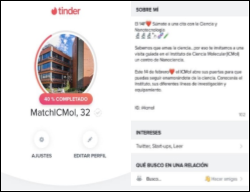
Source: Image taken from Tinder application.
As the Tinder profile was driving traffic to Instagram, during the social media promotion phase, several strategies were applied to the Molecular Science Institute's Instagram profile. These included creating posts in the feed, producing reel-style videos, and sharing stories designed to highlight the Institute as a young and dynamic place. Also, the hashtags #14defebrero #SanValentin #ICMolMatch #SomosICMol were used to increase the visibility of these posts.
Figure 2. Posts on Instagram Feed.
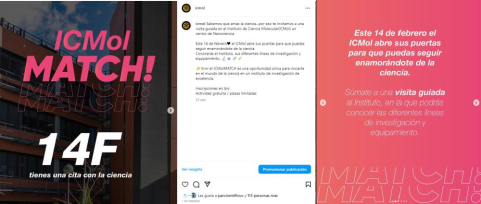
Source: Image taken from the Instagram profile @icmol.
In the stories (published on February 1 and February 14), musical trends that were in tune with Valentine's Day at the time were included in order to improve reach, featuring songs such as SHAKIRA || BZRP Music Sessions #53 and Miley Cyrus - Flowers. In addition, the concept of swiping on stories was leveraged to simulate the Tinder app experience, but in this case, with references to the institute's scientific equipment.
Regarding enrollments, they were carried out centrally through the Eventbrite platform, where interested individuals could access detailed information about the event, including the program, location and FAQs. In addition, the event website maintained the distinctive "ICMolMatch" aesthetics.
The event consisted of a visit to ICMol, where attendees had the opportunity to "match" with different research groups based on their interests. This visit was structured in multiple stations, each of them focused on a specific topic and led by researchers specialized in those topics.
Station 1 - Introduction to the event: It included an introductory talk about the ICMol and its research areas. At this station, each attendee was given a personalized kit with ICMol promotional products and Match stickers of a specific color according to their areas of interest (previously consulted in a form). This color was also associated with the researchers.
Station 2 - Advanced Materials (2D, graphene, spintronics): At this station, a detailed understanding of advanced materials such as graphene and its application in spintronics was provided. Attendees had the opportunity to see the scientific equipment used and learn about the synthesis of graphene sheets.
Station 3 - Porous Materials (MOFs): At this station, porous materials (MOFs) were explored through the participation of two research groups. The directors of these groups explained the basic concepts of porous materials research and its applications in scientific innovation, in addition to showing the equipment necessary to carry out this research.
Station 4 - Atomic Force Microscopy Laboratory: At this station, the atomic force microscopy technique and its use at ICMol was explained in detail. Attendees had the opportunity to observe the tip of the atomic force microscope and explore concepts related to nanometer scale measurement and its applications.
Station 5 - Lithium Batteries, Energy and Electrochemistry: This station introduced the fundamental concepts related to battery development and allowed attendees to visit the scale-up lab, where research in this field is being conducted.
Station 6 - Renewable Energies: This station focused on renewable energies and the generation of sustainable scientific developments. Attendees were able to explore technologies such as OLEDS, LEDS and solar panels, as well as learn about the labs and equipment used.
After completing the stations, a meet-and-greet was held among all participants, including researchers and students, to continue discussing topics of interest and encourage interaction and collaboration. In addition, during the day of the event, we shared posts and stories on Instagram in order to increase participation and interaction with the audience who were engaged in those topics to encourage "matches".
The maximum capacity for the main SOC event was 50 seats, given that attendees needed access to the labs and larger numbers could not be allowed.
Timing and phases of the campaign
The promotion phase of the SOC ran from February 1, 2023 to February 17, 2023. The main event of the SOC was February 14, 2023, coinciding with the celebration of Valentine's Day.
Measurement tools: the free version of the analytics tools Eventbrite and Metricool were used to measure community growth, page reach and clicks, interactions (likes, engagement, clicks and shared posts) and the socio-demographic profile of the SOC's corporate accounts on the social networks Tinder and Instagram.
Also, Google Forms was used to analyze a survey conducted before the event to participants who were asked about the topic of greatest interest.
5. RESULTS
To illustrate the results of the analysis, the graphs elaborated from the data extracted from the publications of the Tinder and Instagram account, through the Metricool, Eventbrite and GoogleForms form applications are presented below and will be commented taking into account the most interesting aspects.
5.1. Record of activity in the Tinder application
The following chart shows the evolution of the number of the number of "matches" obtained in the exclusive profile created for the event. In total, more than 100 "Matches" were obtained between February 1 and February 2, 2023 on the Tinder app.
Figure 3. Record of activity in the Tinder application. Matches.
Source: Data from the Tinder profile ICMolMatch. Elaborated by the authors.
5.2. Community and Instagram profile (@icmol)
At the beginning of the registration, January 1, 2023, the account had 1851 followers, at the end of the event, the account experienced an increase of 23.74% (n=2290).
Figure 4. Monthly follower growth on Instagram June 2022-February 2023.
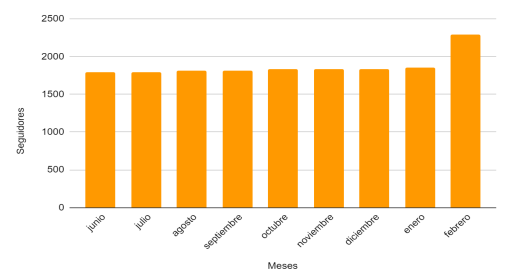
Source: Data from the Tinder profile ICMolMatch obtained from the Metricool platform. Elaborated by the authors.
5.3. Instagram followers by country
Spain accounted for 76% (n=1739), followed by 5.56% (n=127) for Mexico.
Table 1. Instagram followers by country.
|
Country |
Percentage |
|
Spain |
76.32% |
|
Mexico |
5.56% |
|
Argentina |
2.15% |
|
Chile |
1.53% |
|
Colombia |
1.53% |
|
Brazil |
1.34% |
|
Italy |
1.15% |
|
United States of America |
0.92% |
|
Portugal |
0.84% |
|
Germany |
0.73% |
Source: Instagram profile data obtained from the Metricool platform. Elaborated by the authors.
5.4. Impressions of the Instagram profile in the SOC period
At the beginning of the registration, January 1, 2023, the account had 475 views, at the end of the event, the account experienced an increase of 8897.05% (n=42672).
Figure 5. Impressions of the Instagram profile in the SOC period.
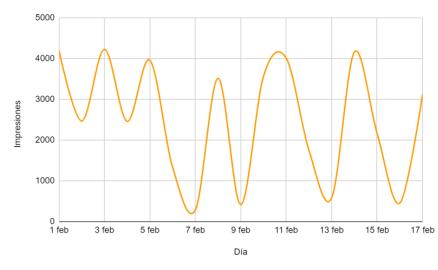
Source: Instagram profile data obtained from the Metricool platform. Elaborated by the authors.
5.5. Average reach of the Instagram account per day in the SOC
At the beginning of the registration, January 1, 2023, the account had 5.74 average reach per day. At the end of the event, the account experienced an increase of 16108% (n=925).
Figure 6. Instagram account reach in the period of the SOC.
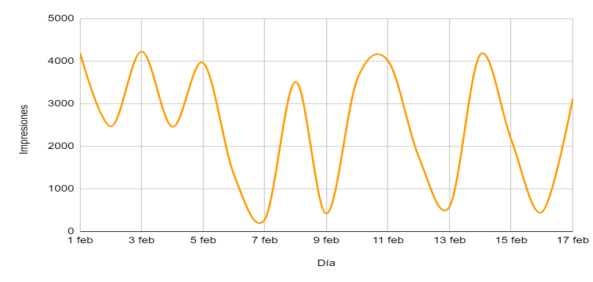
Source: Instagram profile data obtained from the Metricool platform. Elaborated by the authors.
5.6. Story impressions during the SOC period
The story with the highest number of impressions was the February 1 story (n=3685), followed by the story published on February 14 (n=3073).
Figure 7. Impressions of stories in the CDC period.
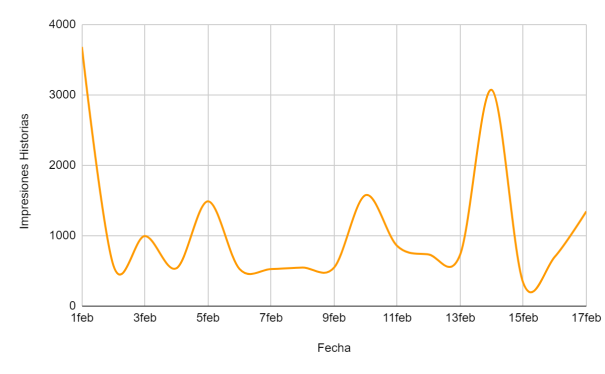
Source: Instagram profile data obtained from the Metricool platform. Elaborated by the authors.
5.7. Distribution of registrants
In the analysis of the registrations, it is observed that the highest number of registrations comes from Physics students of the University of Valencia in the first year, with a total of 18 registrations. The second largest number of registrations corresponds to students of Engineering Physics from the UPV in the second year, with a total of 6 registrants.
In addition to students from the University of Valencia, there were also registrations from people outside the UV, such as students of Engineering Physics from the UPV.
Table 2. Distribution of enrollments.
|
Category |
Number of Students |
|
Students of Physics / University of Valencia / First Year |
18 |
|
Students of Physics / University of Valencia / Second Year |
2 |
|
Students of Physics / University of Valencia / Third Year |
1 |
|
Students of Physics and Mathematics / University of Valencia / Second Year |
3 |
|
Students of Physics and Chemistry Double Degree / University of Valencia / Second Year |
4 |
|
Students of Biotechnology / University of Valencia / Second Year |
1 |
|
Students of Computer Engineering / University of Valencia / Second Year |
2 |
|
Students of Chemistry / University of Valencia / Third Year |
4 |
|
Students of Chemistry / University of Valencia / Fourth Year |
1 |
|
Students of Chemistry Engineering / University of Valencia / Fourth Year |
1 |
|
Students of the Higher Technical School of Engineering, fourth year |
1 |
|
PhD student at IFIC |
1 |
|
Students of Physics Engineering / UPV / Second Year |
6 |
|
Students of Industrial Electronics Engineering / Fourth Year |
1 |
|
Not university students |
4 |
|
Total 50 |
|
Source: Elaborated by the authors. Data obtained from the Eventbrite platform.
5.8. Themes of greatest interest among participants
Atomic Force Microscopy Laboratory has 25.7% of interest, followed by X-ray Diffraction and Photochemistry with 18.1%.
Figure 8. Themes of greatest interest to registrants.
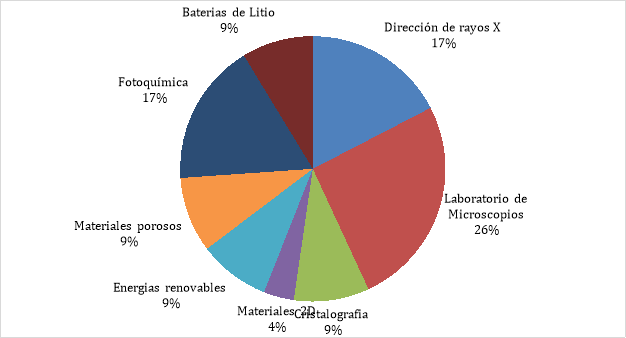
Note. Elaborated by the authors. Data obtained from Google Forms.
Source: Instagram profile data obtained from the Metricool platform. Elaborated by the authors.
5.9. Organic engagement of posts on Instagram in the SOC period. 2021-2023
The engagement in the SOC was 102.3, in the 2021 edition it was 91.88, and in the 2022 edition it was 76.83.
Figura 9. Engagement in the SOC and previous editions.
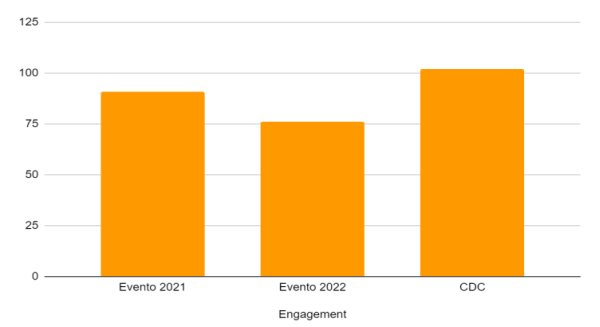
Source: Instagram profile data obtained from the Metricool platform. Elaborated by the authors.
6. DISCUSSION
The lack of interest in digitization in the scientific field and the limited use of digital resources (Villegas et al., 2023), together with the greater receptivity of consumers to content generated by Influencers compared to institutions (Harris et al., 2020), evidences the need to develop professional and carefully planned strategies for interaction on digital platforms, avoiding one-way communication (FECYT, 2021). In this context, the SOC under study has implemented an innovative strategy using Tinder, a social network known for its use in matchmaking, but applying it differently in science outreach. This has resulted in an exponential increase in the SOC's official social networks with respect to previous editions, in which only conventional social networks were used.
During the SOC period, there was a remarkable increase of 439 new followers, in contrast to the low enrollment of previous events. Visits to the Institute's Instagram page also increased significantly exceeding 317%. Another important aspect is that the SOC sold out the number of registrants (n=50) while the event held in 2022 had 12 registrants.
Web 2.0, including social networks, play a fundamental role in the active and collaborative learning process. These tools facilitate asynchronous communication and information exchange in an interactive learning environment (García and Alonso, 2014). However, in the two previous events promoted through conventional social networks, such as Instagram, there was a reduced number of registered university students compared to the SOC.
This evidences the importance not only of employing these digital platforms for promotion, but also of encouraging innovative strategies, as in this case, the use of Tinder to promote the SOC. The figures analyzed reflect the success of the proposal. In addition, it is relevant to highlight that more than 95% of the participants corresponded to the target audience, mainly first year Physics students at the University of Valencia, with a total of 18 registrations. It is also important to highlight that not only the interest of students from the University of Valencia was aroused, since students of Engineering Physics from the UPV also registered, with a total of 6 registrations, which had not happened in any of the previous editions.
Cell phones have become the fastest and most convenient way for the audience to satisfy their needs, such as accessing information and enjoying social entertainment (Dai and Wang, 2023). For this reason, the use of the mobile application Tinder played a crucial role in enhancing the promotion of SOC. Moreover, the decision to direct traffic from Tinder to Instagram proved to be wise, since, according to Alhabash and Ma's (2017) study, students use Instagram more intensively, resulting in more favorable attitudes both affectively and cognitively toward this platform compared to Facebook and Twitter. This was reflected firstly in the SOC getting over 100 matches in a short period of time and secondly in the increase of visits to the Instagram profile compared to previous events. During the SOC, 2556 visits to Instagram were recorded, while in the period of the previous event there were 612 visits.
Universities in Spain have adopted Instagram in their communication strategies. However, despite this widespread adoption, the study highlights a lack of consistency and correct use of Instagram by universities Alcolea et al. (2020). In this framework, it is highlighted that it is not only enough to use Instagram, but that innovative strategies oriented and designed for a specific audience can enhance its reach. In the case of the SOC, the use of the Tinder concept significantly boosted the platform compared to previous periods. Before the SOC promotion phase the Instagram account had a number of 5.74 average reach per day, after the SOC the number increased to 925. In addition, it was evidenced that the impressions of the Instagram account increased significantly, before the SOC the Instagram account counted 475 impressions while in the period of the SOC the figure increased to 42,672 impressions.
In the context of current communication, where traditional media are losing ground to digital and audiovisual opportunities, there is a lack of interest in digitization in the scientific field, as well as a limited use of digital resources for educational purposes (Villegas et al., 2023). This limitation in the use of digital resources may result into less participation in scientific outreach events. As demonstrated by the SOC, the proper use of digital resources not only leads to an increase in attendance at outreach events, but also to greater visibility of the science institutes. In fact, following the science outreach event, the Institute received messages from students interested in internships, as well as requests for guided tours from 12 Physics-Chemistry double degree students and vocational training students.
Nowadays, in the era of the attention economy, it is evident that users of social networks are immersed in an environment saturated with advertising that, for the most part, fails to effectively capture the attention of the public. In response to this problem, the aim is to convey a message that is authentic and focused on the user experience. The underlying objective of this strategy is to establish genuine connections with the audience and stand out naturally (Barquero et al., 2023).
In the context of the SOC, the implementation of the Tinder concept and application succeeded in attracting the attention of students, which not only resulted in a significant increase in page views, but also generated an active community. All of this is reflected in "engagement," which measures the interaction and engagement an audience has with online content, reflecting their level of interest and connection. During the SOC period, engagement reached a value of 102.30, compared to the previous event in 2022, which registered a value of 76.83.
A scientific event has as its main objective the dissemination of research results, arising from the need to share knowledge supported by scientific leaders (Cabrelles, 2020). The SOC's main event fulfills the objective of disseminating research results, as participants were able to learn about different lines of research and the work carried out by each research group of the Institute, including their latest publications, through visits to the stations.
Research institutes should prioritize the creation of an authentic scientific communication environment that promotes dialogue with the public (Carver, 2014). In this context, the main activity of the SOC goes beyond mere science outreach, since, through the Match stickers, each student was able to establish a link with the areas of their greatest interest, thus transforming the experience and stimulating dialogue between attendees and researchers. This approach created an environment of direct communication and identified the topics of greatest interest among the participants, with the Atomic Force Microscopy Laboratory (25.7%) and X-Ray Diffraction and Photochemistry (18.1%) standing out.
As part of their mission, the UCC+i have developed various science outreach activities, including open days, exhibitions, training programs, guided tours and programs aimed at fostering scientific vocations among young people, among other initiatives (González-Pedraz et al., 2018). Despite the offer of these activities for young people, it is important to highlight an innovative strategy for their promotion, which may result in a greater call for applications. In the case of the SOC, the attendance registered in previous events was greatly surpassed. In the previous edition 2022 there were 22 registrants while the SOC was sold out with a total of 50 registrants.
Science outreach through social networks provides an agile and effective platform for the dissemination of knowledge, reaching both experts and the general public almost instantaneously (López and Santillán, 2019). This was clearly demonstrated in the promotion phase of the SOC, where the highest number of visits to the Instagram page, were registered simultaneously with the creation of the Tinder profile.
Younger generations demand stronger visual stimuli to keep their attention on digital platforms, which is reflected in Instagram's investment in features such as reels and stories (Sidorenko et al., 2021). Importantly, in addition to posting in stories, it is necessary to include innovative concepts and "call to action" to capture attention. In this context, stories with Tinder aesthetics were used in the SOC to reinforce the SOC concept.
The predominant language in social networks is fundamentally audiovisual. Therefore, it is essential to adapt informative and dissemination content to the different formats and requirements of each platform (FECYT, 2021). In this framework in the SOC, Instagram stories were used but not in static format since, in addition, musical themes that were trending at the time, related to Valentine's Day, were added. SHAKIRA || BZRP Music Sessions #53 and Miley Cyrus - Flowers were used, thus favoring the algorithm and positioning the stories better. The reach of the stories in the SOC period was 597, while in the 2022 event it was 255. Eighty-five percent of Tinder users are in the 18-34 age range.
Furthermore, although Tinder is presented as a dating app, users often use it as a source of entertainment (Timmermans and De Caluwé, 2017). In this context, the decision to use Tinder as the primary application to promote the SOC proved to be a wise one. The SOC was targeted at the same age group that makes up the majority of the app's users. In addition, the innovative idea of holding a science outreach event on a dating app brought an element of surprise, which generated a greater connection with users looking for entertainment. This means more than 100 matches in 2 days.
"Nearby person apps" (NAPs) represent a category of ubiquitous computing applications that rely on connecting users through their physical location data (Van De Wiele and Tong, 2014). In the SOC's Tinder profile specifications, a specific age range and nearby location were defined. This choice was critical in the SOC's promotion strategy, given that the Institute of Molecular Science is located on the campus of the University of Valencia. This allowed the Tinder profile of the SOC to be displayed on the mobile apps of nearby students. As a result, a 95% match between the registrants and the SOC's target audience was achieved.
Furthermore, when analyzing ICMol's Instagram followers, it is observed that most of them meet the geolocation and age range specifications previously established in the SOC's Tinder app. The majority of Instagram followers are between 18 and 34 years old, 76% come from Spain and most of them reside in Valencia.
As for Tinder's interface, it uses design patterns that share similarities with those used in video games and gaming machines. This creates an experience that invites people to participate in a mechanical game (Garda and Karhulahti, 2021). This resource was also used strategically in Instagram stories, in which the Tinder aesthetic was replicated, but instead of with profiles of people, with scientific equipment. From this adaptation, users had the possibility of viewing the stories and "swiping" in the case of feeling identified with specific lines of research. This strategy generated a total of 16,273 impressions in Stories in the SOC period, in contrast to the 3,514 impressions obtained in the 2022 edition period.
The "Elo score", a complex algorithmic score that takes into account multiple factors. Although it does not directly evaluate a person's physical attractiveness, it does rate their suitability within the platform. In some ways, it could be described as a "large-scale voting system," as each swipe, whether positive or negative, translates into a vote (Kosoff, 2016). Because in a short time SOC's Tinder profile reached more than 100 matches, SOC's profile can be considered to have obtained a favorable Elo score among the profiles on the app.
Unlike the Josep Carreras Foundation's "Un Match por una Vida” (A Match for Life), in the case of the SOC, not only was the Tinder concept adopted, but the interface and mechanics of the application were implemented comprehensively, creating a specific Tinder profile for the event. This innovative strategy led to a noticeable increase in traffic to the Instagram account, as reflected in the results of the visits, and significantly improved the SOC's outreach. Prior to the event the Instagram account had a number of 119 profile views. After the SOC the number increased to 2,437.
In contrast to the Josep Carreras Foundation, during the main SOC event, participants were given the opportunity to "match" on guided tours with researchers using colored stickers. In this way, the SOC was not only inspired by the Tinder concept, but also incorporated its mechanics in a face-to-face manner.
A significant difference is found in the launch of the SOC, which took place close to Valentine's Day, with the main event scheduled for February 14. This strategy allowed to leverage Tinder's "Match" concept and take advantage of the resources associated with this date, such as specific hashtags and popular music themes at the time, #14defebrero #SanValentin.
7. CONCLUSIONS
The strategic use of Tinder in campaigns promoting science outreach events aimed at university students has proven to be highly effective in terms of its ability to attract and engage young university students. In the case of the Science Outreach Campaign (SOC), significantly better results were observed compared to the previous two editions that relied exclusively on conventional social networks.
In the SOC, there was an exponential increase in the number of Instagram followers, along with higher engagement and profile visits compared to the previous editions. In addition, the participation rate at the SOC surpassed the previous two editions, reaching the point of selling out, leading to the addition of alternate day visits. Tinder's interface, combined with its concept, is highly effective in engaging students in an innovative way in the digital environment. In addition, the choice to hold the SOC on Valentine's Day enhanced Tinder's own "Match" concept.
At the SOC, the academic disciplines of greatest interest for the event were identified, with undergraduate physics students being the most interested, followed closely by engineering physics students. The research areas of greatest interest among participants were also identified, including Atomic Force Microscopy, X-Ray Diffraction and Photochemistry.
In this sense, the innovative proposal of promoting a science outreach event can become a resource for application by academics and marketing and communication departments of research institutions or foundations given the potential of the application.
Science outreach through social networks provides an agile and effective platform for the dissemination of knowledge, reaching both experts and the general public almost instantaneously. Social networks have played an important role in the dissemination of scientific knowledge, allowing access to content that in the past might have been forgotten by both senders and receivers of information.
8. REFERENCES
Alcolea Parra, M., Rodríguez Barba, D. and Núñez Fernández, V. (2020). El uso corporativo de Instagram en las universidades privadas españolas. Estudio comparativo de treinta y cinco universidades. Ámbitos. Revista Internacional de Comunicación, 47, 109-134. https://doi.org/10.12795/Ambitos.2020.i47.06
Alhabash, S. and Ma, M. (2017). A Tale of Four Platforms: Motivations and Uses of Facebook, Twitter, Instagram, and Snapchat Among College Students. Social Media + Society, 3(1). https://doi.org/10.1177/2056305117691544
Alonso García, S. and Alonso García, M. del M. (2014). Las redes sociales en las universidades españolas. Revista de Comunicación de la SEECI, 33, 132-140. https://doi.org/10.15198/seeci.2014.33.132-140
Barquero Cabrero, J. D., Castillo-Abdul, B., Talamás-Carvajal, J. A. and Romero Rodríguez, L. M. (2023). Owned media, influencer marketing, and unofficial brand ambassadors: differences between narratives, types of prescribers, and effects on interactions on Instagram. Humanit Soc Sci Commun, 10, 301. https://doi.org/10.1057/s41599-023-01779-8
Cabrelles, G. (2020). Gestión de Eventos Científicos. Servicio de Gestión de la I+ D+ i. UPV. https://bit.ly/3TIlhjU
Carver, R. B. (2014). Public communication from research institutes: Is it science communication or public relations? JCOM, 13(03), 1-14 https://doi.org/10.22323/2.13030301
Dai, X. and Wang, J. (2023). Effect of online video infotainment on audience attention. Humanit SocSci Commun, 10(1), 1-18. https://acortar.link/ExBD2V
Fundación Española para la Ciencia y la Tecnología [FECYT] (2021). Indicadores de actividad en cultura científica en España 2020-2021. Ministerio de Ciencia e Innovación del gobierno de España. https://bit.ly/490tvbn
Garda, M. B. and Karhulahti, V.-M. (2021). Let’s Play Tinder!: Aesthetics of a Dating App. Games and Culture. A Journal of Interactive Media, 16(2), 248-261. https://doi.org/10.1177/1555412019891328
González-Pedraz, C., Pérez-Rodríguez, A. V., Campos-Domínguez, E. and Quintanilla Fisac, M. Ángel. (2018). Estudio de caso sobre las Unidades de Cultura Científica (UCC+i) españolas en la prensa digital. Doxa Comunicación. Revista Interdisciplinar de Estudios de Comunicación y Ciencias Sociales, 26(1), 169-189. https://doi.org/10.31921/doxacom.n26a8
Harris, J., Atkinson, A., Mink, M. and Porcellato, L. (2020). Young People’s experiences and perceptions of YouTuber-produced health content: Implications for health promotion. Health Education & Behavior, 48(2), 199-207.
Kosoff, M. (January 11,2016). You have a secret Tinder rating — but only the company can see what it is. Business Insider. https://acortar.link/1OrR85
López Alonso, S., R. and Santillán García, A. (2019). Las redes sociales son necesarias para la difusión de la ciencia pero no suficientes. Index de Enfermería, 28(4), 171-183. https://ciberindex.com/c/ie/e12683
Morcillo, J. M., Czurda, K., Geipel, A. and Robertson-von Trotha, C. Y. (August 15, 2019). Producers of Popular Science Web Videos: Between New Professionalism and Old Gender Issues. Cornell University. https://doi.org/10.48550/arXiv.1908.05572
Muñoz Gallego, A., de Sousa Lacerda, J. and Costa Araújo, A. (2023). La divulgación científica en Instagram: el reto del discurso audiovisual científico ante los contenidos efímeros. Revista de Comunicación de la SEECI, 56, 149-175. http://doi.org/10.15198/seeci.2023.56.e823
Padilla, J. A. and Díaz-Marcos, J. (2020). Talleres de divulgación científica, una herramienta para la comunicación de la ciencia e ingeniería de materiales. Revista Material-es, 4(2)20-23. https://diposit.ub.edu/dspace/bitstream/2445/166322/1/702149.pdf
Sidorenko Bautista, P., Cabezuelo-Lorenzo, F. and Herranz de la Casa, J. M. (2021). Instagram como herramienta digital para la comunicación y divulgación científica: el caso mexicano de @pictoline. Chasqui: Revista Latinoamericana de Comunicación, 147(1), 143-162. https://doi.org/10.16921/chasqui.v1i147.4472
Timmermans, E. and De Caluwé, E. (2017). To Tinder or not to Tinder, that's the question: An individual differences perspective to Tinder use and motives. Personality and Individual Differences, 110(1), 74-79. https://doi.org/10.1016/j.paid.2017.01.026
Van De Wiele, C. and Tong, S. T. (2014). Breaking Boundaries: The Uses & Gratifications of Grindr. En Proceedings of the 32nd annual ACM conference on Human factors in computing systems (pp. 3553-3562). Association for Computing Machinery. https://doi.org/10.1145/2632048.2636070
Villegas, D., Arana, M., Vilca, V., Saavedra, P., Aguilar, N. and Fernández, S., (2023). Divulgación científica: arte de visibilidad y alto impacto. Horizontes Revista de Investigación en Ciencias de la Educación, 7(27), 468-480. https://doi.org/10.33996/revistahorizontes.v7i27.530
AUTHORS’ CONTRIBUTIONS, FUNDING AND ACKNOWLEDGEMENTS
Conceptualization: López Ortega, Anna Isabel; Almela Baeza, Javier and Munafó Horta, Juan José. Methodology: López Ortega, Anna Isabel; Almela Baeza, Javier and Munafó Horta, Juan José. Formal analysis: López Ortega, Anna Isabel; Almela Baeza, Javier and Munafó Horta, Juan José. Drafting-Preparation of the original draft: López Ortega, Anna Isabel; Almela Baeza, Javier and Munafó Horta, Juan José. Drafting-Revision and Editing: López Ortega, Anna Isabel; Almela Baeza, Javier and Munafó Horta, Juan José. Visualization: López Ortega, Anna Isabel; Almela Baeza, Javier and Munafó Horta, Juan José. All authors have read and accepted the published version of the manuscript: López Ortega, Anna Isabel; Almela Baeza, Javier and Munafó Horta, Juan José.
AUTHORS:
Anna Isabel López Ortega
International University of Valencia.
annaisabel.lopez@universidadviu.com
PhD in Political Science and a BA in Journalism and Political Science at the University of Valencia. She has been a scholar at the Higher Center for Scientific Research (CSIC). She has more than 15 years of professional experience in university teaching and political and parliamentary consultancy in different cabinets and public institutions. She is currently director and professor of the Master's Degree in Communication and Political Marketing at the International University of Valencia. Her main lines of research focus on political communication, political parties, ideology and strategy of the European and Spanish extreme right, as well as hate speech, xenophobia and racism.
Índice H: 8
Orcid ID: https://orcid.org/0000-0002-8611-6615
Google Scholar: https://scholar.google.com/citations?user= C0ByCioAAAAJ
Javier Almela Baeza
University of Murcia.
PhD in Audiovisual Communication from the University of Murcia UMU and professor of the Department of Communication of the School of Communication and Documentation of the UMU. Main Researcher of the European project Erasmus+ SurgicalComm and author of more than 24 articles in journals indexed in JCR on scientific dissemination, communication in the field of organ donation and creation and impact of content for social networks.
Orcid ID: https://orcid.org/0000-0003-0003-4967
Juan José Munafó Horta
International University of Valencia.
Degree in Audiovisual Communication (UNSAM) and specialized in Digital Communication, with a Master's Degree in Scientific Communication (VIU). Training in Advertising Creativity and Higher Technical Diploma in Communication and Image. Extensive experience in communication and scientific dissemination at the Argentine Nanotechnology Foundation (FAN) and the Technology Transfer Observatory (OITEC).
Orcid ID: https://orcid.org/0009-0001-2544-309X
